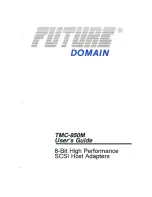
Using Your RAID Enclosure
31
RAID 0 is best used for video editing, image editing, prepress applications, or any application requiring
high bandwidth.
RAID 1 offers fast performance and the best data availability, but also the highest disk overhead. It is best
used for accounting, payroll, or financial applications.
RAID 5 is best used for file, application, database, web, e-mail, news, and intranet servers.
RAID 10 works well for medium-sized databases or any environment that requires high performance and
fault tolerance and moderate-to-medium capacity.
Segment Size
Disk striping enables data to be written across multiple physical disks. Disk striping enhances
performance because striped disks are accessed simultaneously.
The segment size or stripe element size specifies the size of data in a stripe written to a single disk. The
MD3000 supports stripe element sizes of 8, 16, 32, 64, 128, 256, and 512 KB. The default stripe element
size is 128 KB.
Hot Spares and Rebuild
A valuable strategy to protect data is to assign available physical disks in the storage array as
hot spares
. A
hot spare adds another level of fault tolerance to the storage array.
A hot spare is an idle, powered-on, stand-by physical disk ready for immediate use in case of disk failure.
If a hot spare is defined in an enclosure in which a redundant virtual disk experiences a physical disk
failure, a rebuild of the degraded virtual disk is automatically initiated by the RAID controller modules.
If no hot spares are defined, the rebuild process will be initiated by the RAID controller modules when a
replacement physical disk is inserted into the storage array.
Global Hot Spares
The MD3000 supports global hot spares. A global hot spare can replace a failed physical disk in any
virtual disk with a redundant RAID level as long as the capacity of the hot spare is equal to or larger than
the size of the configured capacity on the physical disk it replaces, including its metadata.
Hot Spare Operation
When a physical disk fails, the virtual disk automatically rebuilds using an available hot spare. When a
replacement physical disk is installed, data from the hot spare is copied back to the replacement physical
disk. This function is called copy back. By default, the RAID controller module automatically configures
the number and type of hot spares based on the number and capacity of physical disks in your system.
Summary of Contents for PowerVault MD3000
Page 68: ...68 Troubleshooting Your Enclosure ...
Page 100: ...100 Glossary ...
















































